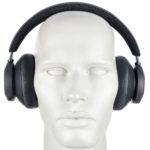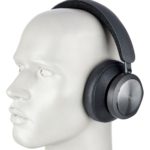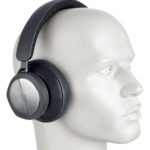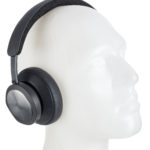With the Beoplay Portal PC PS, Bang & Olufsen has brought a remarkable pair of headphones onto the market. They understand, like no other manufacturer, how to skilfully combine aspects like “hi-fi”, “travel”, and “gaming” into a stylish design. Above all, compared with the Xbox version, the new Portal excels with even better battery life and simultaneous connection via wireless and Bluetooth. These features are complemented by choice of materials and manufacturing quality that leaves nothing to be desired. Bang & Olufsen have succeeded with this multi-platform approach, no question about it, and that deserves hearty approval. Nevertheless, they also have to face some criticism: the noise cancelling could have been more effective for our taste.
With the Bang & Olufsen Beoplay Portal PC PS, the Danish hi-fi designers present a gaming headset that boasts premium features as well as high-quality materials. Thanks to wireless connectivity, low-latency gaming is possible, plus high-quality music listening or telephony via Bluetooth – including adaptive noise cancelling (ANC, noise suppression) and transparency mode. However, all this comes at a price.

Since Bang & Olufsen’s successful debut with the Beoplay Portal in April 2021, the manufacturer has added another contender to its gaming headset portfolio. The new model is also called “Beoplay Portal”, but it is aimed specifically at PC and Playstation users – which is signified by the abbreviation “PC PS”
What can the Beoplay Portal do?
Before we go into detail, a few words of clarification are needed because Bang & Olufsen’s headphones, while aimed at gamers, are not just for gaming.
The Portal has several interfaces: the headphones establish a wireless connection with high bandwidth and low latency to PCs and PlayStations via an included dongle. Bluetooth 5.1 with aptX Adaptive Codec, among others, is available for mobile devices, computers can be connected via USB-C, and an analogue mini-jack connection ensures the integration of additional players such as DACs or other game consoles.
Additionally, the core features include adaptive noise cancelling and a transparency mode – functions not usually associated with gaming headsets.
Design & Workmanship
In this area, B&O, as always, get top marks because, typically, these headphones for gamers are made from premium materials. The headset we tested came in black and anthracite (light grey and blue are also available) and had a headband covered in lambskin, with breathable, knitted bamboo fibre padding and a discreet notch in the middle to relieve pressure on the skull. Aluminium rails, which extend as smoothly as butter, are embedded in it, and ear cups with soft lambskin ear pads and all the controls hang from it. The two aluminium discs with the manufacturer’s logo on the outside of the ear cups not only have very discreet gradient anodisation that reflects differently depending on the light quality, but they also have touch functionality, with commands activated by tapping.
Comfort
The manufacturer’s design and material choices result in a total weight of just 279 grams, distributed comfortably by the headband so that we could wear the headphones for hours without discomfort. The contact pressure was firm but not too tight. Thanks to the lack of a ratchet, the aluminium earpieces can be adjusted with millimetre precision. The soft, replaceable lambskin pads (approx. 5.5 cm x 5 cm) with their memory foam filling have a contoured shape and become slightly thicker towards the bottom, so they rest on the jawbone to relieve pressure. However, this results in a slight external noise attenuation in the mid-range.
Operation
As with other B&O headphones, the aluminium surfaces on the ear cups serve as controls. Here, however, you have to distinguish which mode is currently active: if you tap twice quickly on the left when the Bluetooth connection is active, playback is started or paused. During phone calls, this is how you reject or end calls; in gaming mode (i.e. with the dongle), the EQ modes are activated or deactivated. In Bluetooth mode, a double tap on the right jumps to the next track; during calls, this action accepts the call and mutes/arms the microphone. The latter also applies when in gaming mode.
That’s it for touch gestures; other commands use the built-in buttons and sliders. Bars on the back of the left and right ear cups are operated like sliders. They allow you to change the volume (right) and to switch from transparency mode to noise cancelling (left); in gaming mode, you can set your own voice (“Own Voice”) and the ANC. Two small, slightly raised dots signal the end of the control range. In addition, the Portal also provides an audible notification when you reach the maximum control ranges.
The two small buttons on the bottom of the ear cups are quickly explained. On the left, you can activate Bluetooth; if you press the button for a few seconds, pairing becomes active. On the right, the small button is used to connect to the wireless dongle; pressing and holding turns the headphones on/off.
All control gestures were executed reliably and quickly, and even the wildest “slider rides” did not cause the Portal to lose its balance.
However, we felt that some control options were missing. For example, it’s not possible to skip back music tracks or to fast-forward and rewind within a track.
Bluetooth
B&O Beoplay Portal PC PS has Bluetooth version 5.1 and provides AAC and aptX Adaptive in addition to the lowest common denominator codec, SBC. The aptX Adaptive codec offers a dynamic compression ratio of 5:1 to 10:1, can deliver up to 24 bits/48 kHz and has data rates of 276 kBits and 420 kBits.
This gaming headset is also capable of multipoint: two devices can be connected to the headphones simultaneously, and up to eight players can be added. Portal automatically connects with the last device paired. If this is not found, the headphones scan the connection list for other devices.
The wireless link is relatively stable; in closed rooms, the first dropouts only occurred after about 15 metres, while almost 30 metres was possible in open spaces. In addition, these headphones support Google Fast Pair and Microsoft Swift Pair; they are also certified as “Made for iPhone”.
Battery life
The manufacturer claims up to 19 hours of battery life when the headphones are used in Gaming Mode (along with Bluetooth and ANC) and up to 42 hours when using Bluetooth only with ANC turned on. Compared to the Xbox version, the manufacturer has almost doubled the battery life! These are really very good values, although they were not quite achieved in practice, as many factors such as volume or temperature played a significant role. The lithium-ion battery has a capacity of 1,200 mAh, takes us about two and a half hours to recharge and can be replaced if necessary.
Connections
Besides the wireless connection via Bluetooth, Portal also has other connection options. The USB-C cable not only serves as a charging cable but also transmits audio. Accordingly, these headphones can be used as a USB headset on a computer, for example, including Dolby Atmos playback.
In addition, thanks to the included dongle, they offer a wireless connection option so that low-latency gaming on PCs and Playstations (PS4 and PS5) is possible using 2.4 GHz wireless technology.
Furthermore, the Portal can be connected with an analogue mini-jack cable. If you’re pleased that you can use these headphones passively despite an empty battery, you’re celebrating too soon because this operating mode also requires power. However, the advantage is that the gaming headset will then provide all technical amenities such as noise-cancelling or control via touch or buttons – even on a Nintendo Switch or Microsoft Xbox. When the headphones are operated in this mode, they cannot be connected to a smartphone via Bluetooth.
No other gaming headset currently offers such flexible connection options, and the manufacturer deserves praise for that! The limitations of the Beoplay Portal for Xbox no longer exist with the Beoplay Portal PC PS; for example, it’s possible to have Bluetooth and wireless connections simultaneously, so you can take calls on a smartphone while continuing to play in parallel on a PC or Playstation.
App
With the free app for iOS and Android, you can edit various settings on the Bang & Olufsen Beoplay Portal PC PS. However, registration or logging in with your Facebook or Google account is mandatory. Once you’ve registered, you can change or save the specially adapted EQ settings and playback controls (track forward and back, play, pause). You can use a slider to switch from ANC to Transparency Mode or to change the automatic connection to the dongle and Bluetooth. Firmware updates are also possible, as is the administration of other B&O products.
If the Portal is connected via dongle, it virtually switches over, so those special EQ settings such as “FPS”, “RPG”, or “Movie” are now available. These can also be edited and saved, although it is not possible to adjust them on a matrix as you can in Bluetooth mode; instead, it is done via 5-band EQ.
As already mentioned, this headset supports virtual surround sound. To achieve this, you need to download the Dolby Access app from the Microsoft App Store, register the Portal and then receive a licence that is valid for life.
Noise Cancellation and Transparency Mode
As mentioned above, this headset also offers Adaptive Noise Cancellation and a transparency mode – both rather atypical for gaming headphones.
Fortunately, these two “business features” are not just half-baked add-ons but actually deliver quite decently.
To be fair, Bang and Olufsen’s noise-cancelling has never been able to match the effectiveness of a Sony WH-1000XM4 (to the review), and the same is true of the new model. But the noise cancellation works well, with low frequencies neatly cancelled out, while high frequencies remain quieter but still perceptible.
The so-called diving bell effect is absent from this model, and – also pleasing – the overall tuning of these headphones hardly changes audibly as a result. Of course, a slight noise is audible, but this is due to the system and is not at all annoying, especially when the headphones are playing media content. The noise-cancelling can be altered at five levels, from subtle to high, either via the slider on the headphones or via the app.
The same applies to the Transparency Mode, which in its “Max” setting delivers somewhat overemphasised highs, noticeably raises the background noise and does not achieve the naturalness of the Apple AirPods Max (to the review). Therefore, we rate this function as good but not perfect.
Microphone
You won’t find a boom microphone on the Portal. Instead, the manufacturer relies on a series of microphones that, thanks to beamforming, can isolate and amplify your voice while suppressing background noise. The voice quality is not crystal-clear, but it is acceptable enough to ensure good speech intelligibility. However, this solution is not suitable for podcasters and streamers, who would be better off looking for a higher-quality microphone solution.
In addition, the “Own Voice” function records the volume of one’s voice and filters out background noise. This is controlled via the left-hand slider.
Sound
If you appreciate the sound signature of other Bang & Olufsen headphones, you’ll enjoy the Bang & Olufsen Beoplay Portal PC PS. The warm foundation of the Beoplay Portal PC PS is capable of delivering a crisp and tight bass, while the mid-range builds cleanly on it and seems harmonious and balanced without pushing itself to the fore. In the upper registers, the Portal is just as confident. Even high-frequency material is reproduced without any real sharpness, which means these headphones are destined for hours of fatigue-free listening.
Even though the Portal has integrated DSP, it does not achieve the airiness and openness of an open headphone system, but movements in the sound field can always be tracked, enabling accurate localisation. Due to the closed system, “listening in-depth” is more limited than it would be with open headphones. Nevertheless, with the Portal PC PS, Bang & Olufsen demonstrate, once again, how well their sound tuning works across genres. Dense electronica tracks are just as convincingly reproduced by these headphones as playful jazz numbers or brutal metal songs.
The Portal shows its best side in Gaming Mode and when watching films, especially if Dolby Atmos has been successfully installed. Footsteps, gunshots or explosions can be reliably located in the virtual surround field. Compared to pure stereo headsets, gamers will have a distinct advantage. Absolute hardcore gamers might miss a certain “thump” if the headphones don’t have enough punch. But they can intervene with the equaliser to configure and save their settings accordingly.
Technical specifications
- Ear couplingOver-ear
- Typeclosed
- Transducer principledynamic
- Frequency response (headphones)20 - 20.000 Hz
- Impedance+/- 15%: 24 Ohm ohms
- Sound pressure level (SPL)106,83 dB
- Pressure averaged from big and small head586 g
- Weight with cable293 g
- Weight without cable280 g
- Cable length120 cm
What's in the box
- Mini jack cable
- USB-A to USB-C cable
- USB-C dongle
- USB-C to -A adapter
- Fabric bag
Special features
- Available in black/anthracite, grey mist and navy
- BT codecs: SBC, AAC, aptX Adaptive
- BT version: 5.1
- Dolby Atmos license






















































